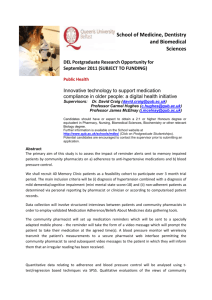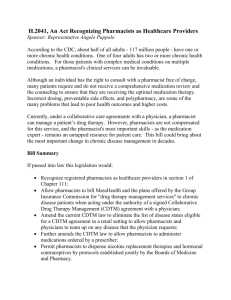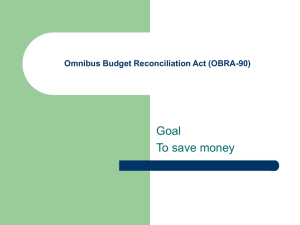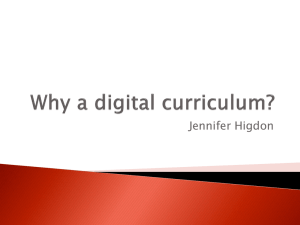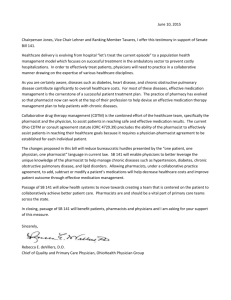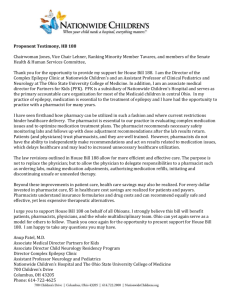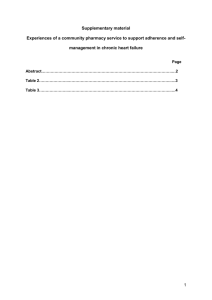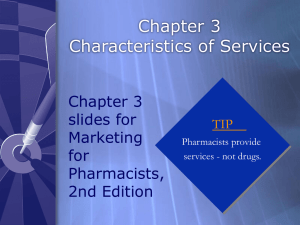Pharmacist-Patient Health Information System (PPHIS)
advertisement
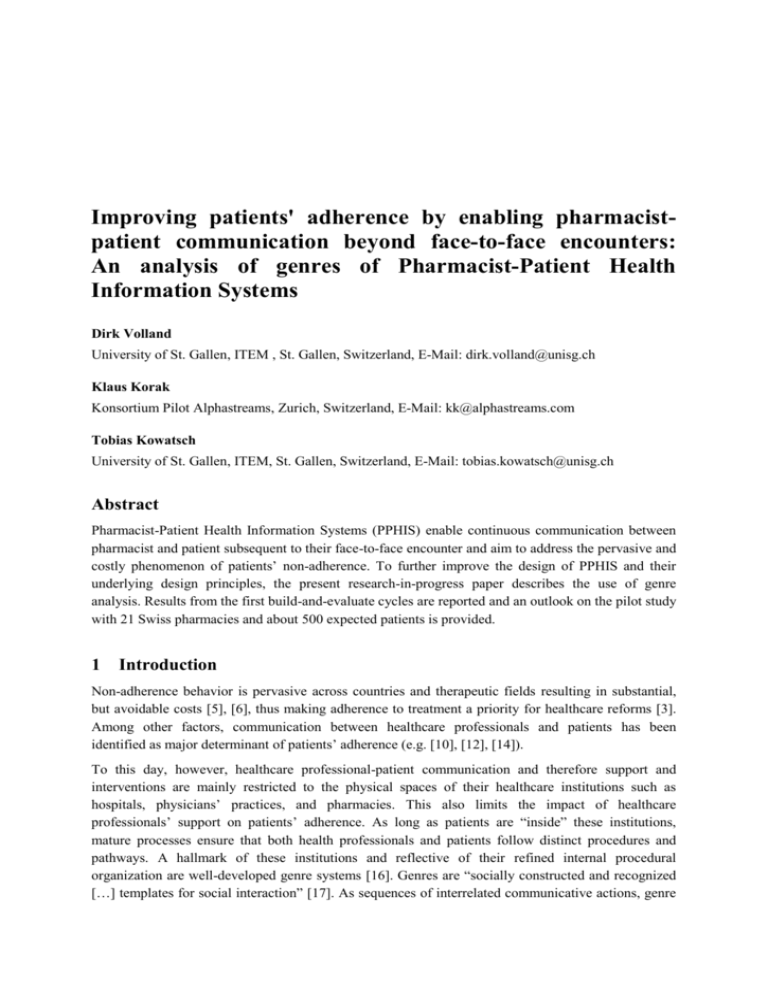
Improving patients' adherence by enabling pharmacistpatient communication beyond face-to-face encounters: An analysis of genres of Pharmacist-Patient Health Information Systems Dirk Volland University of St. Gallen, ITEM , St. Gallen, Switzerland, E-Mail: dirk.volland@unisg.ch Klaus Korak Konsortium Pilot Alphastreams, Zurich, Switzerland, E-Mail: kk@alphastreams.com Tobias Kowatsch University of St. Gallen, ITEM, St. Gallen, Switzerland, E-Mail: tobias.kowatsch@unisg.ch Abstract Pharmacist-Patient Health Information Systems (PPHIS) enable continuous communication between pharmacist and patient subsequent to their face-to-face encounter and aim to address the pervasive and costly phenomenon of patients’ non-adherence. To further improve the design of PPHIS and their underlying design principles, the present research-in-progress paper describes the use of genre analysis. Results from the first build-and-evaluate cycles are reported and an outlook on the pilot study with 21 Swiss pharmacies and about 500 expected patients is provided. 1 Introduction Non-adherence behavior is pervasive across countries and therapeutic fields resulting in substantial, but avoidable costs [5], [6], thus making adherence to treatment a priority for healthcare reforms [3]. Among other factors, communication between healthcare professionals and patients has been identified as major determinant of patients’ adherence (e.g. [10], [12], [14]). To this day, however, healthcare professional-patient communication and therefore support and interventions are mainly restricted to the physical spaces of their healthcare institutions such as hospitals, physicians’ practices, and pharmacies. This also limits the impact of healthcare professionals’ support on patients’ adherence. As long as patients are “inside” these institutions, mature processes ensure that both health professionals and patients follow distinct procedures and pathways. A hallmark of these institutions and reflective of their refined internal procedural organization are well-developed genre systems [16]. Genres are “socially constructed and recognized […] templates for social interaction” [17]. As sequences of interrelated communicative actions, genre 2 Dirk Volland, Klaus Korak, Tobias Kowatsch systems organize the temporal, spatial, and social dimensions of interactions between healthcare professionals and patients [17]. Structured communication and with it associated genre systems come to an abrupt halt as soon as patients leave these institutions. Communication and, in turn, interaction and collaboration “outside” institutions is absent or unstructured at best. This absence and the resulting loss of guidance have detrimental effects on patients’ adherence, and therefore on therapy quality, outcomes, and associated costs [5], [10]. The current work aims to address this fundamental asymmetry between “inside” and “outside” by developing a system that enables community pharmacists to follow-up and efficiently support their patients over the time of convalescence. Pharmacist-Patient Health Information Systems (PPHIS) enable continuous communication between the pharmacist and the patient subsequent to their face-toface encounter [12]. Because it is still unknown which communicative practices are created by and emerge in a PPHIS, the general objective of the work at hand is to gain a principal understanding of communicative practices by employing genre analysis [16]. Genre analysis allows for the investigation of emerging communicative practices and their organizational implications when introducing new information systems [8], [16]. This approach has been successfully applied in the healthcare context investigating clinical information systems [4] and in the design and evaluation of IS [1], [4], [7]. Once identified, genres can be used as organizing structures that shape social interactions [17] in an effort to increase patients’ adherence to treatment regimes. An example of existing genres and genre systems in pharmacist-patient interaction is presented in Figure 1. All elements represent genres or subgenres. For example, the face-to-face encounter represents a subgenre of the prescription fill process, but a genre with regard to the subgenre of usage instructions. The prescription fill process consists of a sequence of interrelated genres, i.e. the prescription, the face-to-face encounter, the drug label instructions, and the personalized drug information letter that together form a genre system. More specifically, to further improve the PPHIS and its design principles that were developed in the first build-and-evaluate cycles [12], we seek to gain a better understanding of communication between pharmacists and patients and how it needs to be structured and designed when the patient has left the pharmacy. This information is needed to pre-configure communication functionality of the PPHIS and as such instantiate the system with specific genres that structure communication between pharmacist and patient that go beyond providing the ability to spontaneously communicate as it could already be realized by email or SMS communication. We therefore ask: Which communicative genres, i.e. communication functionalities, need to be integrated into PPHIS? In the remainder of this paper, we first describe the PPHIS in more detail. Then we introduce methods, followed by first results. We conclude with presenting expected theoretical and practical contributions of our research. Figure 1: Example of genres and genre system (prescription fill process) Multikonferenz Wirtschaftsinformatik 2014 2 3 Pharmacist-Patient Health Information System (PPHIS) PPHIS, its definition, theoretical background, and underlying design principles have been introduced in [12]. Based on these design principles (cf. Table 1), a prototype consisting of a communication and monitoring interface for pharmacists tailored to a tablet-PC and a communication interface for patients in the form of a smartphone application was implemented and evaluated. Figure 2 shows the business process model diagram [11] of the general process of interaction between pharmacist and patient that is enabled by the PPHIS. The left part of the diagram illustrates the process inside the pharmacy and the right side the interaction after the patient has left the pharmacy. The PPHIS combines the following functionality: First, it enables the pharmacist to configure a follow-up with the patient that is structured by several interaction-elements over the time of the patient’s therapeutic process. Examples of interaction elements are the provision of health information on a specific day and several feedback types like the request for therapy progress or success, medical parameters like blood pressure, or feedback in form of a photo. Following configuration, a personalized code is generated that is provided to the patient in person and additionally send to the patient’s mobile phone by SMS including a download link for the patient-app. Upon activation of the app using a personalized code, the pre-configured interaction elements can be accessed and completed by the patient at the respective time points following the pharmacy-visit. A typical follow-up for a patient with eczema could involve text or video-based information on how to apply an ointment on the first day, a request to report progress or a photo of affected skin on the fifth day, and a final success control on the tenth day. In addition to the pre-configured elements, pharmacist and patient can also spontaneously use a chat-like dialog-feature to exchange textual information or ask questions, as well as arrange personal follow-up appointments using an integrated booking system. Table 1 shows how design principles of the PPHIS match the implemented functionality. Table 1: PPHIS design principles and functionality Design Principle [12] DP1 (Extended communication): Pharmacist can follow up with a patient and communicate with a patient during the time of therapy and adjust it depending on feedback from patient. DP2 (Information): Pharmacist can provide health-information to a patient during the time of therapy. DP3 (Motivation): Pharmacist can motivate a patient during the time of therapy. DP4 (Strategy): Pharmacist can provide strategic support to a patient during the time of therapy. DP5 (Instantiation): Pharmacist can choose from a given set of informational, motivational, and strategic elements and instantiate them for the given situation over a specified time pattern. Functionality Pharmacist can pre-configure a follow-up for a patient that triggers communication and feedback events and as such structures the follow-up. Ad-hoc communication can be started from both pharmacist and patient whenever needed through a chat-like dialog function. Pharmacist can choose among the following interaction elements when pre-configuring a follow-up, respectively start an ad-hoc communication during therapy when needed: (1) Photo-Feedback, (2) Therapy-Success-Feedback, (3) Send message, (4) Therapy-Progress Feedback, (5) Arrange follow-up appointment, (6) Pain-Scale-Feedback, (7) Medical-Parameter-Feedback, and (8) Question &Answer. Pharmacist can pre-configure and save interaction templates that include patterns of interaction elements and they can adjust these templates for individual patients at the time of the face-to-face encounter. 4 Dirk Volland, Klaus Korak, Tobias Kowatsch Figure 2: 3 BPMN diagram of pharmacist-patient interaction with the PPHIS Method The introduced PPHIS has been pre-evaluated in 21 Swiss pharmacies over a period of two months. Pharmacists were asked to run follow-ups of their choice with internal staff but as realistic as possible with regard to the defined situation and indication and the process of the follow-up. After completion, 20 of the pharmacists were interviewed and completed an online survey. We asked for the usefulness of the different communication-features of the system on a 7-point Likert-scale ranging from strongly disagree (1) to strongly agree (7). One-sample t-tests were applied to check if the calculated average differs from the scale’s medium of 4. 4 First Results and Outlook The pharmacy-internal pilot with 102 employees taking the roles of both pharmacists and patients included 307 instantiations of follow-ups that resulted in a total of 1042 interactions of which 778 were textual messages between pharmacist and patient and 264 were feedback documentations. In the absence of actual patients, content analysis of existing messages was of limited value, but gave first indications of a possible future usage by pharmacists. “Patients” extensively used pre-configured structured feedback types, however, the amount of messages sent shows also the importance of spontaneous communication. Pharmacists stressed the importance of a flexible but fast configuration of follow-ups. With regard to the results of the subsequent survey, pharmacists rated the feedback by photo as the most useful one (Mean: 6.37, SD: 1.01, p<.001). Feedback on final therapy success was ranked second (Mean: 5.89, SD: 0.93, p<.001) and sending a message to a specific patient third (Mean: 5.84, SD: 1.25, p<.001). The other features were feedback on therapy progress (Mean: 5.79, SD: 1.13, p<.001), arrangement of a personal appointment (Mean: 5.26, SD: 1.33, p<.001), feedback on a pain scale (Mean: 5.16, SD: 1.34, p<.001), feedback parameters such as blood pressure (Mean: 5.00, SD: 1.79, p<.05), sending health information (Mean 5.00, SD: 1.63, p<.01), and question and answer (Mean: 4.95, SD: 1.51, p<.01). The expected duration of follow-ups ranged from one to more than eleven days. The findings from the continuous interaction with the pharmacists during the design cycle and the survey provide an answer to the research question and resulted in the user interfaces as shown and described in Figure 3 and Figure 4 that will be used in the field study as described in the following. Starting from this first instantiation of genres, we will have a field study involving actual patients of the 21 pharmacies beginning in September 2013. We expect about 500 patients to use the PPHIS over a period of two months. For each follow-up, we collect data that defines the context of the follow-up: Multikonferenz Wirtschaftsinformatik 2014 5 pharmacist’s defined purpose of follow-up, pharmacist’s defined diagnosis, drug, duration, predefined structure and content of follow-up, as well as demographic variables such as gender and age. Generated log files will be analyzed quantitatively and qualitatively involving textual analysis and a coding scheme based on the 5W1H framework that can be used to analyze communication for emerging genres [17]. The framework postulates six questions to assess purpose (why), content (what), participants (who), timing (when), location (where), and form (how) of a genre. Coding reliability will be judged using two additional researchers to code a stratified sample of messages and by calculating Cohen's kappa. This analysis provide purposes, forms, contents, and frequency of communication that emerge within the usage of the PPHIS by pharmacists and patients and therefore enable the identification of genres that can be used to further pre-structure the communication. Social network analysis techniques [15] will be used to analyze how genres are interrelated and connected in form of genre systems. Here, genres present the nodes of the network, while the edges represent the strength and direction of the ties between different genres. The respective calculations will be done using UCINET 6.456 [2], providing first insights into the contexts under which specific communication needs of participants evolve, i.e. recurring patterns and sequences of communication. In addition to the collected data, patients and pharmacists receive a survey at the end of each therapy cycle that asks about the patient’s adherence behavior based on a rating scale to measure medication adherence as suggested in [9]. This will provide insights into how the usage of the PPHIS influences patients’ adherence. Figure 3: Pharmacist user interface on a tablet-PC 6 Dirk Volland, Klaus Korak, Tobias Kowatsch Figure 4: Patient user interface on a smartphone: (1) Main screen’s therapy circle, (2) Dialog with pharmacist, (3) Example of a feedback element (therapy progress feedback) 5 Expected Theoretical and Practical Implications In the study and outlook detailed in this research-in-progress paper, we describe the analysis of communicative practices that emerge in a PPHIS by employing the concept of genre of communication. Presented results that are based on first usage of the PPHIS prototype by pharmacists and a survey provide initial insights into which genres should be instantiated in PPHIS. With regards to theoretical contributions, this study suggests the use of genre analysis to identify how communication, its structure and elements, could be pre-structured in PPHIS. It extends the work of [12] and provides a first instantiation of genres. With regard to practical contributions, this study introduces genres of communication that are valuable from a pharmacist’s point of view with regard to using PPHIS. The right instantiation of PPHIS might provide an efficient solution to extend communication beyond the personal encounter inside the pharmacy and provide pharmacists a tool to guide their patients throughout the therapeutic process, which may improve patients’ adherence but also their satisfaction with the therapeutic process and their loyalty to the pharmacist. The pharmacist, being in many cases the last healthcare professional in personal contact with a patient that starts a therapeutic process, may be the right person to address patients’ non-adherence behaviors in the future, also for economic reasons when being compared with the physician. PPHIS and their efficient configuration are a prerequisite for starting this process. The paper presents the current state in the design research process. The findings so far are limited to the perspective and evaluation of pharmacists but neglect the patient’s view and actual behavior. This limitation will be addressed within the field study involving actual patients of the 21 pharmacies. 6 References [1] Antunes, P; Costa, CJ (2003): From genre analysis to the design of meetingware. In Proceedings of the 2003 int. ACM SIGGROUP conference on Supporting group work, New York, US. Multikonferenz Wirtschaftsinformatik 2014 7 [2] Borgatti, S; Everett, M; Freeman, L (2002): Ucinet for Windows: Software for Social Network Analysis. Harvard, MA: Analytic Technologies. [3] Cutler, DM; Everett, W (2010): Thinking Outside the Pillbox − Medication Adherence as a Priority for Health Care Reform. New England Journal of Medicine 362(17): 1553–1555. [4] Davidson, E (2000): Analyzing genre of organizational communication in clinical information systems. Information Technology & People 13(3): 196–209. [5] DiMatteo, MR; Giordani, PJ; Lepper, HS; Croghan, TW (2002): Patient adherence and medical treatment outcomes: a meta-analysis. Medical Care 40(9): 794–811. [6] DiMatteo, MR; Haskard-Zolnierek, KB; Martin, LR (2012): Improving patient adherence: a three-factor model to guide practice, Health Psychology Review 6(1): 74–91. [7] Firth, D (2002): Emergent online communities: The structuring of communicative practices over the Internet. In Applegate, L; Galliers, R; DeGross, J (eds.), Proceedings of the 23rd International Conference on Information Systems. Barcelona, Spain. [8] Firth, D; Lawrence, C (2003): Genre analysis in information systems research. The Journal of Information Technology Theory and Application (JITTA) 5(3): 63–77. [9] Kalichman, SC; Amaral, CM; Swetzes, C; Jones, M; Macy, R; Kalichman, MO; Cherry, C (2009): A simple single-item rating scale to measure medication adherence: further evidence for convergent validity. Journal of the Int. Association of Physicians in AIDS Care. 8(6): 367-374. [10] Martin, LR (2010): Health behavior change and treatment adherence: Evidence-based guidelines for improving healthcare. Oxford University Press. [11] Object Management Group (2011): Business Process Model and Notation (BPMN). http://www.omg.org/spec/BPMN/2.0. Accessed on 01.09.2013. [12] Volland, D.; Korak, K.; Brückner, D.; Kowatsch, T., (2013): Towards Design Principles for Pharmacist-Patient Health Information Systems, 8th International Conference, DESRIST 2013, Helsinki, Finland, June 11-12, 2013, Proceedings Vol. 7939 LNCS, Springer, Germany, 519-526. [13] Taitel, M; Jiang, J; Rudkin, K; Ewing, S; Duncan, I (2012): The impact of pharmacist face-toface counseling to improve medication adherence among patients initiating statin therapy. Patient preference and adherence 6: 323-329. [14] Thompson, L; McCabe, R (2012): The effect of clinician-patient alliance and communication on treatment adherence in mental health care: a systematic review. BMC Psychiatry 12(1): 87. [15] Wasserman, S; Faust, K (1994): Social network analysis: Methods and applications (8th ed.), Cambridge University Press. [16] Yates, J; Orlikowski, W (1992): Genres of Organizational Communication: A Structurational Approach to Studying Communication and Media. The Academy of Management Review 17(2): 299–326. [17] Yates, J; Orlikowski, W (2002): Genre Systems: Structuring Interaction through Communicative Norms, Journal of Business Communication 39(1): 13–35.
